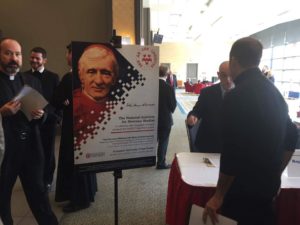
The National Institute for Newman Studies partnered with Duquesne to present a lecture on digitally preserving many of Newman’s formerly unpublished documents.
Kaye Burnet | Staff Writer
10/19/17
The late Catholic Cardinal John Henry Newman was many things — an Anglican priest, a Catholic convert, a poet, a lecturer and if his 40 published books and roughly 21,000 remaining letters are any indication, a prolific writer.
When he died in 1890 at age 89, he left behind a vast collected of unpublished letters, notes, photographs and other artifacts. Until recently, the majority of these archives could only be accessed by visiting the Birmingham Oratory, a Catholic religious community of the Congregation of the Oratory of St. Philip Neri located in Birmingham, England.
Now, thanks to modern technology and a transatlantic partnership between the Birmingham Oratory and several Pittsburgh institutions, Newman’s archives will be accessible online for the first time.
With funding from the Duquesne University-affiliated National Institute for Newman Studies and advanced photography equipment from Oakland-based research firm Crivella West, more than 200,000 of Newman’s documents have been digitized. The project took three years to complete, according to Birmingham Oratory archivist Daniel Joyce, who gave a presentation on the project in Duquesne’s Power Center Ballroom on Oct. 16.
According to Joyce, scholars from many disciplines, including classics, music, theology and philosophy, have consulted the physical archives at Birmingham. He said that, far from decreasing with time, global scholarly interest in Newman is growing, particularly as it becomes increasingly likely that Newman will be named a saint in the Catholic church.
“The interest is truly universal and very healthy,” Joyce said.
Now, scholars around the world will be able to access Newman’s writings without making the trip to England and sitting in a “stuffy room, surrounded by intimidating piles of boxes,” Joyce said.
The digitization project began in 2014 and cost approximately $500,000, according to www.newmanarchive.wordpress.com, a blog created to document the project. More than 200 boxes of material were photographed using advanced lighting and image capturing techniques, with a total of 233,886 images generated.
According to Joyce, the digitization project also offered an opportunity for Newman’s physical archives to be reorganized and stored in more suitable conditions. Previously, boxes and loose papers had been piled around the Birmingham Oratory almost haphazardly. Now they are cataloged and housed in acid free boxes on properly constructed shelving units.
Joyce cautioned that scholars won’t discover anything too surprisingly in the archives, and he told researchers not to expect any “eureka moments” that change the way Newman or his scholarship is viewed.
“It is by Newman’s public works that he should be judged … [The archives] can serve to put flesh on the bones of the man,” Joyce said. “Reading these documents can only result in a deepening of faith.”
According to Joyce, the next step the Birmingham Oratory wants to pursue is to establish a permanent library and reading room for the Newman archives. Joyce said that instead of replacing the physical archives, he expects the digital archives will actually encourage more scholars to want to visit the Oratory.
If Newman is canonized, or made a Catholic saint, that would also increase the number of visitors beyond the current facilities’ capabilities. The cost of such a project would be around $3.6 million, according to the Birmingham Oratory website.


